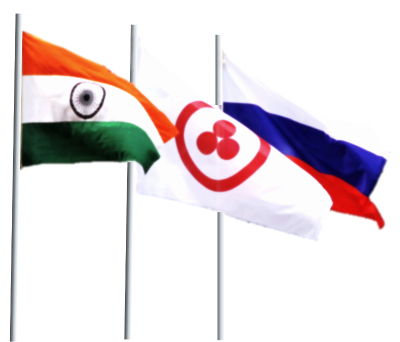Roerich Estate Garden
Our outstanding compatriots, the painter, traveler and writer Nikolai Roerich and his sons Svetoslav, painter, and Yuri, orientalist, lived and worked in India in the 1930s-1940s. In Naggar (Kullu) they set up the Institute of Himalayan Studies (International Scientific Center) — Urusvati, which cooperated with such outstanding scientists from different countries as Albert Einstein, Louis de Broglie, Nikolai Vavilov and others. At present, due to the efforts of the International Center of the Roerichs (Moscow), staff members of the Main Botanical Gardens named after N. Tsitsin, RAS, the Zoological Museum of Lomonosov Moscow State University and Indian colleagues, scientific studies are reviving there: the authors collected materials for this article when studying plants of Nikolai Roerich’s estate in Naggar in 2010-2011 and documents from the archives of the International Roerich Center.
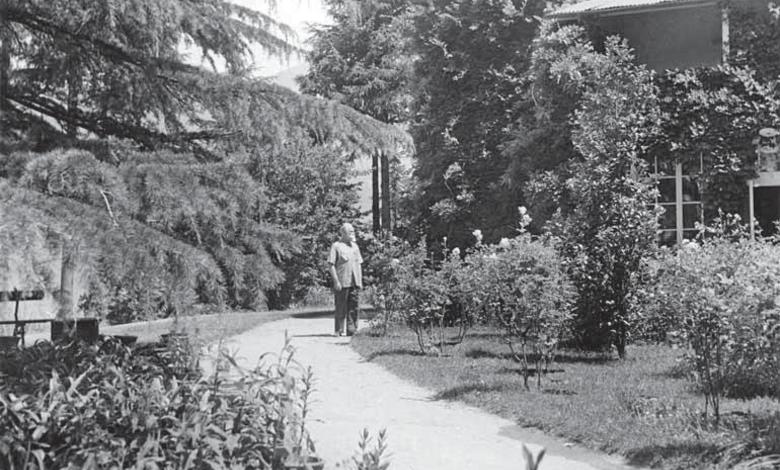
Opposite the entrance to the estate, on the steep slope one can see Acacia dealbata, well-known in Russia and simply called here mimosa. To the right, near the southern facade of the house, there grow an evergreen, century old, magnificent Magnolia grandiflora and nearby several multitrunk lindens (Tilia cordata), brought by the Roerichs from Russia to remember the faraway home-land by.
The walls of the building are twined all over by Wisteria schinensis , an evergreen Rosa banksiana with multiflorous bunches of small yellow very fragrant flowers. Among other lianas we can single out Campsis radicans and Jasminum sp.
N. Roerich and Jawaharlal Neru near the Four-trunk Pine. 1942
Authors: Vladimir SHATKO, Cand. Sc. (Biol.), Svetlana POTAPOVA, Cand. Sc. (Biol.), senior research assistants of the Main Botanical Gardens named after N. Tsitsin, RAS, Viktor FROLOV, Dr. Sc. (Philos.), deputy director general of the Museum of N. Roerich (Moscow)
The Himalayas are the highest mountains in the world. There is a picturesque Kullu Valley in their northwestern part, located in the Indian state of Himachal Pradesh (it is also called the Valley of 360 gods). It spreads from north to south along 80 km, now widening up to 2-3 km, now narrowing till a narrow canyon. The rapid Beas river runs along its bottom. The tops of surrounding ridges are crowned with snow caps and the slopes are covered with thick forests with Deodar cedar predominating.
The Kullu Valley is first mentioned in the ancient Makha-bkharata , the characters of which began their way from there. Long ago it was regarded as an end of the world, but from the late 19th century it became a resort, where British officers used to take their families to rest.
It is not accidental that here, in the Kullu Valley, Nikolai Roerich decided to settle down. This is a place he chose after long travels-expeditions in Tibet and the Himalayas.*
In 1928, Nikolai Roerich bought a house in Naggar, located 40 km to the north of Kullu, in the upper reaches of the valley at the height of almost 2,000 m; this simple in architecture building of 1880, had earlier belonged to an English colonel. The house is surrounded by a small, but cosy park**, located on the three terraces of the western slope of the ridge on the left bank of the Beas.
A winding paved lane and several garden staircases, traditionally made of local flat stones like slate, lead to the last, lower terrace. The slope proper is planted all over with Diospyrus lotus and apple trees. On the left side of the slope one can see one of the miracles of the park, though it can be assessed properly only in autumn — in late October-November. It is Prunus cerasoides, a rather big tree, abundantly flowering in autumn without leaves. It is a striking sight: branches covered with beautiful soft-pink flowers on the eve of winter. The plum is also an aboriginal, i.e. a representative of the local Himalayan flora.
This third terrace of the park is the biggest. Eight trees, like the scenes, rise from the eastern side along its entire length in a single row. It is formed by the Himalayan cedar, Deodar pine and linden. In late October, when autumn makes linden crowns golden, one can feel here Russian country estate coloring. As if you were somewhere near Tula or Moscow, not in the Himalayas.
Besides the park, the country estate also included at that time an adjacent part of the Deodar cedar and Himalayan pine forest, a kitchen-garden and a big orchard with 1,500 fruit trees, including a great number of varieties of apple, peach, cherry, apricot, pear, plum, quince, medlar, chestnut, hazel nut, walnut and grape trees. According to the description of the country estate (from the archives of the International Roerich Center) the fruits were of perfect quality and were highly assessed at local agricultural exhibitions.
Svetoslav Roerich’s letters contain interesting notes and descriptions of some corners of the park, state of certain plants, changes in the estate territory as well as poetical sketches on the nature of Kullu Valley:
“Kullu is beautiful as before, bright colors, very much snow… Many changes have taken place. Indian Pride (above-mentioned Indian lilac. — Auth. ) is cut off, as it was broken by heavy snowfall. Magnolia is now taller than the house, but one side is damaged. Wisteria is in full bloom… I want to plant a thousand apple-trees. Had we done this in 1940-1941, now we would have good results. So, you must not be afraid to improve something you have. The more so as it is so simple.”
April 27, 1951. From the letter to Helena and Yuri Roerich.
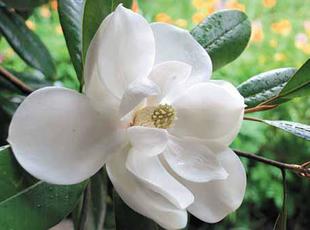

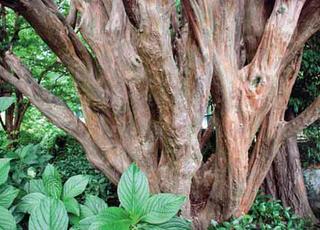
Southern Magnolia
(Magnolia grandiflora)
Lily of the Nile
(Agapanthus umbellatus)
Trunk of Indian lilac
(Lagerstroemia indica)
“…Now magnolia feels better here, but it is early for flowers. Wisteria was in blossom, and small yellow roses (Banks Rose. — Auth. ). A great number of white daffodils, lilacs, peonies, and roses. Camellia L. has grown. All were in blossom. A lot of orchids, which I have planted 15 years ago, also in blossom. In general, the garden is well preserved.”
April 18, 1958.
From the letter to Yuri Roerich, Lyudmila and Iraida Bogdanovs.
(Bogdanov sisters — assistants and keepers of a part of the heritage of the Roerichs. — Auth. )
* See : O. Lavrenova, “Up Hill and Down Dale”, Science in Russia , No. 5, 2011.— Ed.
** Studies of the country park, herbarium and other biological collections, gathered in many expeditions of the Roerichs in the different areas of Central Asia, Tibet and the Himalayas and today kept at the Urusvati institute, are carried out by the International Roerich Center and staff members of the Main Botanical Gardens named after N. Tsitsin, RAS, within the framework of the program of preservation and studies of the scientific and cultural heritage of the Roerichs in India.— Auth .
Present-day photos by V. SHATKO, S. POTAPOVA and D. SURGIN.
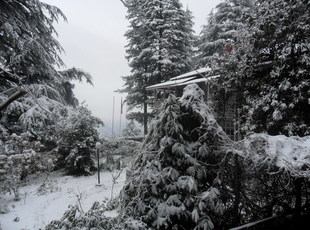
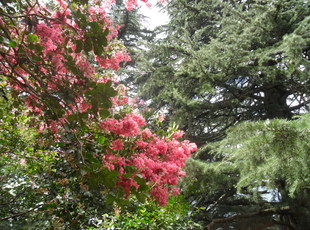
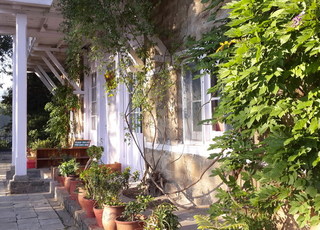
The Garden in winter
Wisteria schinensis and Rosa banksiana climbing the Roerich House wall
The narrow alley leads to the building under the protection of magnificent Cedrus deodara and Lagerstroemia indica — a multi-trunk high shrub with an umbellate crown. In spring shrubs are covered with thick blossom clusters made of numerous bright-pink double flowers. Hence its local name — Indian pride. In autumn Legerstroemias blazing like a fire with its bright foliage, contrasting with evergreen branches of neighboring cedars, and look especially striking at night on the background of snowcovered mountains on the other side of Kullu Valley.
The path, leading to the house, is surrounded by an evergreen Euonymus japonica, which forms a hedge. Behind it to the right are big shrubs of Hydrangea macrophylla with enormous caps-blossom clusters of faded-blue flowers. The hedge encircles a triangular front garden, in the center of which one can see two compact trees of Camellia japonica, several shrubs of roses (white and purple), Daphne papyracea and Abutilon sp. To the left from the path, under the age-old cedars, the whole space is planted with Agapanthus umbellatus — a decorative perennial plant from the Liliaceae family with thickened rhizomes and long dark-green lori-form leaves, gathered into a rosette. Its violet flowers on long peduncles are gathered into an umbellate blossom cluster; sometimes the flower number can reach 80! Such attire rises above ground almost 1 m due to long peduncles.
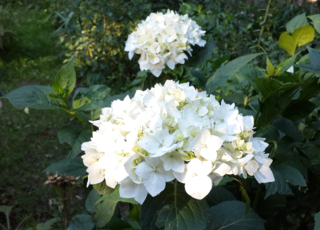
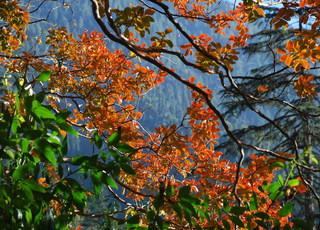
Cedrus deodara
Hydrangea macrophylla
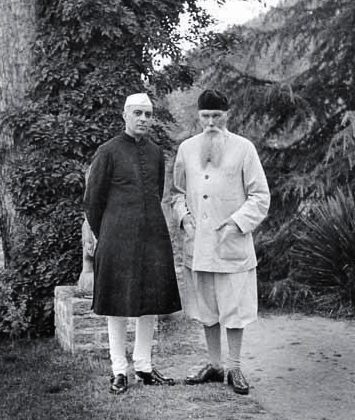
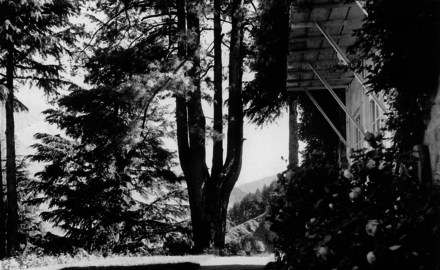
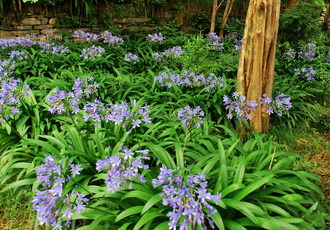
Agapanthus umbellatus
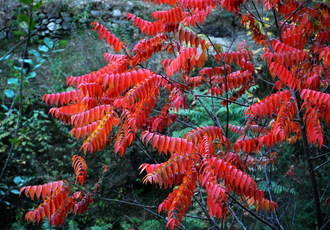
Rhus wallichiana in red autumn finery
In front of the western façade, overlooking Kullu Valley, there is also a front garden with a lawn, limited in perimeter by a Japanese spindle-tree hedge. This open space allows to see from the windows a wide panorama of the valley and the river Beas below and majestic ridges of the Himalayas, as if leaning against the sky. The northern part of the terrace, where the mansion is located, is covered with lindens, Ailanthus altissima and shrubs of Hibiscus syriacus . This part of the park is also famous for its Himalayan pine (Pinus wallichiana), under which one can see stone statues of local Hinduist gods, collected by Nikolai Roerich (one of them, called Guga Chokhan, a rider on the horse, is depicted in the painter’s pictures). This tree is one of the oldest as well as the tallest in the park, it is 150-200 years old, and 40 m high! By the way, neighboring Deodar cedars are not inferior to the pine in height. The northeastern part of the estate is distinguished for its majestic Cryptomeria japonica — the sole representative of this species in the region.
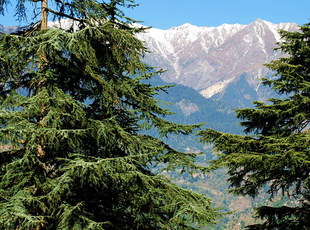
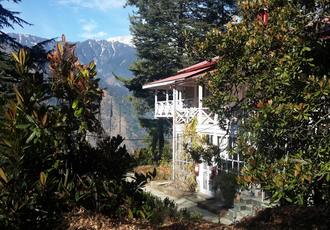
Magnolia grandiflora trees
near the House
A rather steep garden staircase with stone steps leads to the next terrace of the park, located lower along the slope. There grow Yucca sellowiana, brought once to the valley by Englishmen and today widely spread in Naggar and its environs. This small terrace, limited by stone breast-walls, is a place, where the house of Svetoslav Roerich and his wife Devica Rani is located. A short alley, planted all over with shrubs of Lagerstroemia and Buxus sp. leads to it. There are triangular and rectangular front gardens with young shrubs of Buxus sp. in front of the house, and a small open area at the back north side with a beautiful view of the upper reaches of Kullu Valley. Along its edge and on the northern slope there grow Celtias australis, Armeniaca vulgaris, Deodar pine, and also shrubs of dogrose and Callicanthus sp.

Cryptomeria japonica and Diospyrus lotus trees in their summer and autumn fineries
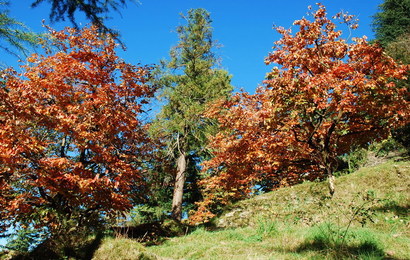
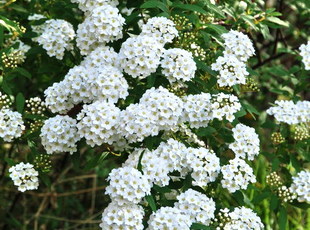
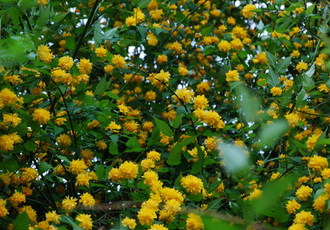
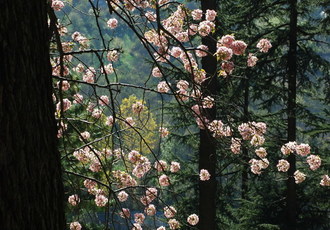
Kerria japonica
Spiraea vanhouttei
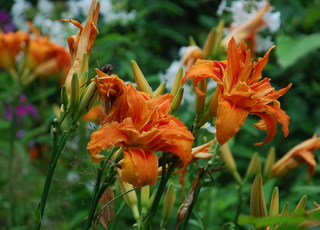
In the center of the area there raises a grey stone, placed at the place of cremation (“samadhi”— literally “a place of brightening, liberation of the soul”) of Nicholas Roerich. From the terrace you can see practically the whole of Kullu Valley with silver streams of the river below and woody slopes of the mountains, the peaks of which are covered with snow. The picture would not be complete without huge trees of cedar, pine and chestnut, growing lower along the slope, along the periphery of the terrace of the park. All in all, there are growing more then 40 species of trees and shrubs. Flowers are represented by an enormous number of perennial and annual decorative cultures, changing each other in the course of almost a year. In different periods of the year the park is decorated with roses, daffodils, violets, marigold, chrysanthema, plantain lilies, day lilies, gladiola and many other known and unknown plants. According to Svetoslav Roerich, he used to cultivate even orchids in the garden. On the photos from the archives one can see lilies, peonies and a great number of roses — favorite flowers of Helena Roerich.
But the park was different before. The old photos of the estate, evidently made at the time of its buying, show how the house and its surroundings looked at that time. The walls were twined all over with Banks Rose and wisteria (on the side of the façade). The fact that these lianas covered the most part of the house, it can be affirmed that they were planted by former owners — Englishmen. On both sides of the main entrance there are seen Spanish daggers. The space around the building was completely open and a greater part was covered with a lawn, which served as a background for a great number of rose shrubs. Nothing obstructed the view of Kullu Valley — the trees of Deodar cedar, growing lower along the slope, were not yet sufficiently tall to close a wonderful view of the environs. Behind the house grew only a four-trunk Himalayan pine, preserved up to the present time. It is a place where the Roerichs and their distinguished guests used to be photographed.
Four-trunk Himalayan Pine near the Roerich House
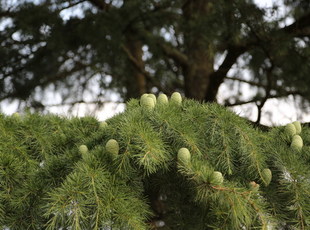
The Garden in autumn colours
Cedrus deodara cones
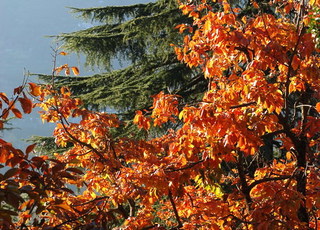
Prunus cerasoides


The southern facade of the Roerich House
N. Roerich. Krishna (Spring in Kullu). 1930

S. Roerich in the Garden
“This year Kullu was especially beautiful. The more you travel, the more you become convinced that it is difficult to find more beautiful place. Our trees have grown greatly. Everything is somehow green, shady. Behind the house — linden, on the northern slope — a big vigorous tree. Magnolia in full blossom and has long overgrown the house…”
June 29, 1959.
From letters to Yuri Roerich, Lyudmila and Iraida Bogdanovs.
“Someday, dear friend, you must come here, to stay here for a while, in order to feel the Spirit of real India and experience the feelings you cherish so greatly. The feelings one cannot express, but which make us live and work, which fill us. …You will be happy to learn that even today hundreds of visitors go up to Naggar to see pictures of the professor Roerich there in the gallery, they make wonderful entries in the visitors’ book, which I intend to publish… I cannot describe the feeling of pacification we feel here, this is an entirely different world, and it seems that it really gives you a new life, and you understand that in fact nothing matters — besides work and admiration of the beauty of these wonderful mountains. These mountains fill with this beauty the people’s soul too. Now the colors are not so delicate as in early spring or autumn, but nonetheless they strike by their remarkable palette… The mountains are in snow, but now, when I am writing, it is raining cats and dogs, and I see how snow falls on the mountains in front of me. Cherries are already ripe, and soon we’ll have all varieties of perfect cherries from our own trees…”
May 9, 1964.
From a letter of Devica and Svetoslav Roerichs to Pavel Belikov.
(P. Belikov — a biographer and researcher of N. Roerich’s works. — Auth. )




